Excavations have revealed 35 pre-Roman pit burials, covered in amphorae and arranged in an alternating neck and tip formation.
According to the Superintendence, the necropolis was discovered during construction work for an underground car park on Via Fucci, a short distance from the Roman city.
Researchers analysed the amphorae and have estimated that they date from the 3rd to 1st century BC, originating from North Africa, evidenced by the maker’s hallmark in the Punic language, Carthaginan.
The skeletal remains are well preserved and contain sparse objects of unguentarium (small ceramic bottles) and several coins- due to the anaerobic conditions from being submerged in groundwater.
More pre-Roman objects were found in a canal, they’re associated with destroyed funerary contexts. These include tile fragments, preserved wood, amphorae and dolia- an earthenware vessel used for storage and goods transportation.
The canal also contained 20 columella made from volcanic stones, tiles stamped in the local Oscan language, and a stone head made from grey Campanian tufa, depicting a woman with preserved red paint.
According to archaeologists, the canal was supposedly built after Sulla’s siege of Pompeii during the Social War (91-87 BC), a conflict between the Roman Republic and several autonomous allies, including Pompeii.
Traces of an extensive field system were also found under thick layers of pumice from the Vesuvian eruption in AD 79. The field system has evidence of ancient furrows and pits in a N-S direction, supplying markets and households with fresh produce in Roman Pompeii.
Organic remains and pollen are also being analysed to identify the vegetables that were grown.
However, the root systems and distribution indicate that perennial artichokes were likely cultivated in the area.

